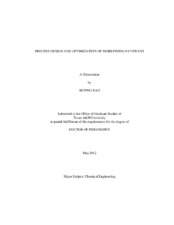Process Design and Optimization of Biorefining Pathways
Abstract
Synthesis and screening of technology alternatives is a key process-development activity in the process industries. Recently, this has become particularly important for the conceptual design of biorefineries. A structural representation (referred to as the chemical species/conversion operator) is introduced. It is used to track individual chemicals while allowing for the processing of multiple chemicals in processing technologies. The representation is used to embed potential configurations of interest. An optimization approach is developed to screen and determine optimum network configurations for various technology pathways using simple data.
The design of separation systems is an essential component in the design of biorefineries and hydrocarbon processing facilities. This work introduces methodical techniques for the synthesis and selection of separation networks. A shortcut method is developed for the separation of intermediates and products in biorefineries. The optimal allocation of conversion technologies and recycle design is determined in conjunction with the selection of the separation systems. The work also investigates the selection of separation systems for gas-to-liquid (GTL) technologies using supercritical Fischer-Tropsch synthesis. The task of the separation network is to exploit the pressure profile of the process, the availability of the solvent as a process product, and the techno-economic advantages of recovering and recycling the solvent. Case studies are solved to illustrate the effectiveness of the various techniques developed in this work.
The result shows 1, the optimal pathway based on minimum payback period for cost efficiency is pathway through alcohol fermentation and oligomerized to gasoline as 11.7 years with 1620 tonne/day of feedstock. When the capacity is increased to 120,000 BPD of gasoline production, the payback period will be reduced to 3.4 years. 2, from the proposed separation configuration, the solvent is recovered 99% from the FT products, while not affecting the heavier components recovery and light gas recovery, and 99% of waster is recycled. The SCF-FT case is competitive with the traditional FT case with similar ROI 0.2. 3, The proposed process has comparable major parts cost with typical GTL process and the capital investment per BPD is within the range of existing GTL plant.
Citation
Bao, Buping (2012). Process Design and Optimization of Biorefining Pathways. Doctoral dissertation, Texas A&M University. Available electronically from https : / /hdl .handle .net /1969 .1 /ETD -TAMU -2012 -05 -10836.


